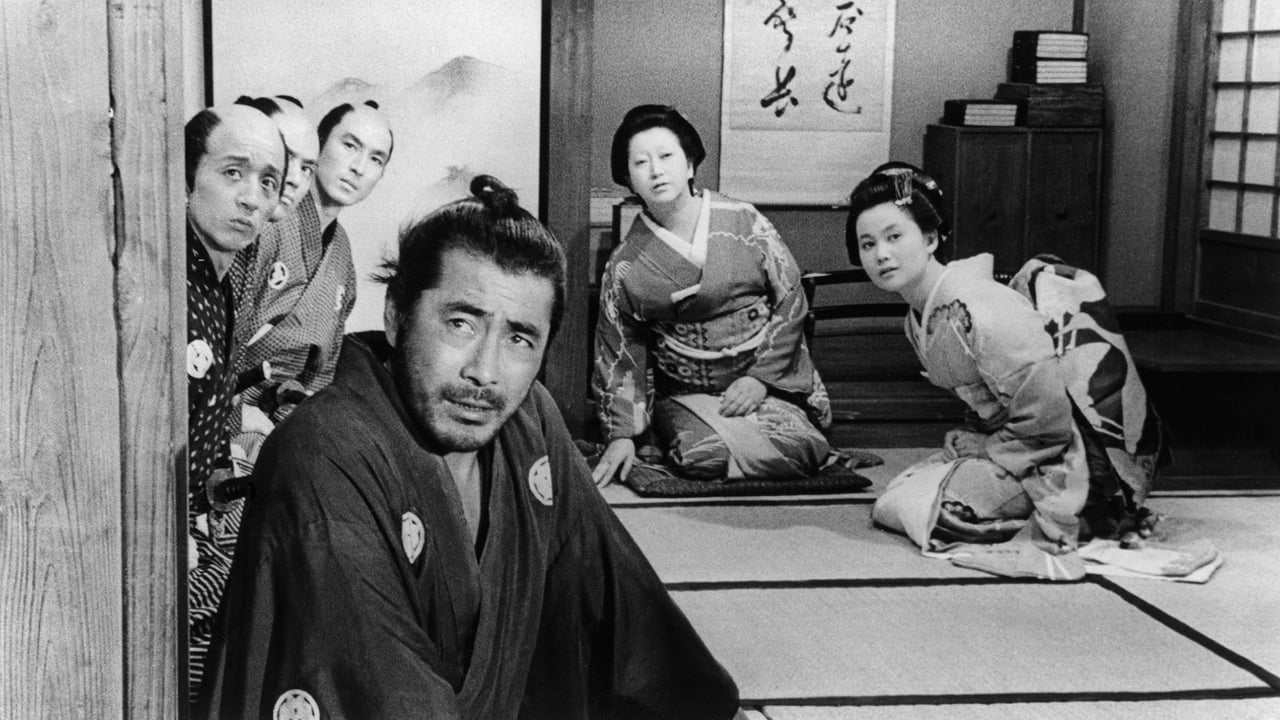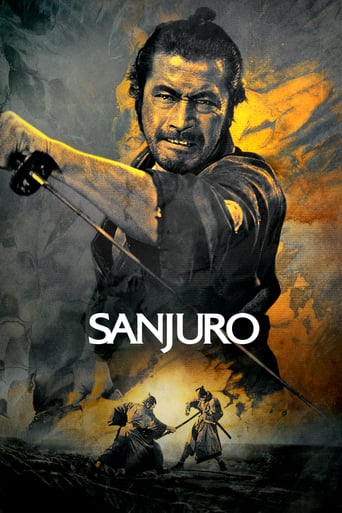



Wonderfully offbeat film!
Masterful Movie
Crappy film
Best movie of this year hands down!
I watched "Yojimbo" and "Sanjuro" back to back and couldn't help feeling I liked the follow up sequel just a bit better, even though the earlier film is the one that's much higher regarded and better known. Toshiro Mifune reprises the title character, but we learn in this story that he never really lets anyone know his real name or identity. In "Yojimbo", he called himself 'Kuwabatake', the mulberry, whereas here, contemplating a camellia bush, he refers to himself as Sanjuro Tsubaki, the camellia. In each picture he made a joke about being 'Sanjuro', sanju the word for 'thirty', acknowledging that his age was 'closer to forty'.Though I found this picture entertaining enough, it's hard to take any of the things going on very seriously. It's almost as if the story is a caricature of samurai life. It's pretty ridiculous actually, that a hundred guys with swords couldn't have put an end to Sanjuro the first time Superintendent Kikui's clan came calling on chamberlain Mutsuta's followers. Sanjuro takes out a handful and there's no repercussion for killing them! In what reality does something like that happen?Similarly, I got a kick out of the scene in the latter part of the story when Mutsuta's clan was waiting for that signal from Sanjuro when he went over to the Kikui place. For starters, when the guards from Kikui's hideout looked through the hedge, the Mutsuta location was there - right next door! And then, attempting to have the guards inadvertently send the warning signal to attack, Sanjuro stated that if the white camellias show up in the stream, the opposing clan was supposed to attack, but if they received no signal at all, they would take it as a sign that Sanjuro was in trouble, and they should attack as well! Fortunately, no one bothered with the red canellias.But I'll tell you what, that final showdown between Sanjuro and Muroto (Tatsuya Nakadai) was one for the ages. I actually had to run that segment of Mifune retrieving his sword in slow motion to see how he did it because it occurs so fast in real time that it looks fake. And if one doubts that a comic element supersedes in this picture, one need only contemplate the fire hydrant gushing of blood that emitted from Muroto. I think I might have matched the nine members of the Mutsuta clan in wide eyed astonishment.
View MoreA crafty samurai helps a young man and his fellow clansmen save his uncle, who has been framed and imprisoned by a corrupt superintendent.Toshiro Mifune's sword fighting in the film was used in an extensive illustrated example of "samurai virtuosity with his sword" in "This is Kendo", a kendo manual published in English. As it should be! This is seen as a more light-hearted sequel to "Yojimbo", and indeed it is one of the few films I am aware of where samurai dance around in joyful glee. The violence is relatively low-key, with one crucial moment of gore, and the tone at times is even a bit humorous. Although not as praised as "Yojimbo", perhaps it should be.
View MoreThis sequel to 'Yojimbo' sees the ronin samurai helping a group of men. One of them took their concerns about local corruption to his uncle, the chamberlain, but was rebuffed; he then went to the superintendent to tell him he believed his uncle was part of the problem. The Superintendent agrees and tells those concerned to get together for a meeting. It is as the group are being told this that the mysterious samurai walks in on them and explains why their conclusions are wrong and that it is the superintendent who is corrupt and that by coming together they have made it easy for him to kill them all. As the superintendent's men approach to attack he manages to save them. He now has to help them rescue the chamberlain in order to prove who is really guilty. It won't be easy though as those he is trying to help don't fully trust him and many of their actions end up making matters worse for them all.It was good to see Toshirô Mifune return as the lone samurai; he is great in the roll as he brings an enjoyable mix of humour and roughness to the part. The story itself is fairly simple; the opening scenes set things up and after that there are no real twists that doesn't matter though as the story is well told and enjoyable to watch; this is largely down to Akira Kurosawa's expert direction. Who the most part the fight scenes are fairly bloodless which makes the final scene somewhat shocking as here there is a huge burst of blood! There some amusing moments too; I liked how the samurai was either resting or asking for food much of the time while all around him were keen to get on and do something. Overall this film is well worth watching and if you are a fan of Kurosawa's other films it is must see.
View MoreI do love Akira Kurasawa's movies, especially Seven Samurai, Ran, Ikiru, Rashomon, Yojimbo, The Hidden Fortress and Throne of Blood. Sanjuro(sequel to Yojimbo) is not quite on the same level, but it is a fine film regardless and perhaps alongside The Hidden Fortress Kurasawa's most accessible film. It is very well made, with beautiful and sometimes epic scenery and superb camera work. Kurasawa directs with his usual flair, not as delicate as Ikiru, haunting as Yojimbo or as ambitious as Ran, but still highly impressive. The score is lively, the story is engaging, crisply-paced and always fun and the script is witty and tongue-in-cheek yet with a subtle edge. The characters are somewhat one-dimensional and not quite as identifiable as the titular character in Ikiru but still likable nonetheless, and Toshiro Mifune's lead performance is a very subtly fun one indeed. Overall, a great film but not my favourite from Kurasawa. 9/10 Bethany Cox
View More